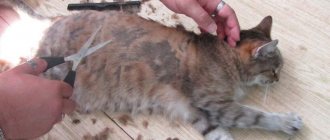What will you learn from the article?
- Cat training - list of commands
- Training cats at home - basic principles Contact me
- Bring it
- Sit
- Lie
- Stand
- Kiss
- Give me your paw
- Jumping through a hoop
- Stand on your hind legs
Dogs are trained in a huge number of kennels and special schools; cats are less fortunate - they are mostly trained at home. Let's look at the basic principles of cat training and the most common commands that you can teach your pet yourself at home.
You can train a kitten when it is 7-8 months old. It is at this age that the animal has matured enough to adequately perceive the owner’s instructions and try to follow them.
Cat training is an activity that requires patience on the part of the cat owner. Before you start training, you need to carefully observe the cat and study all its habits, favorite activities and games, and character traits. Such observation will help you competently create a training program, organize training in stages and get the most out of your pet.
Cats' ability to learn
Cats have a developed emotional sphere and a finely organized psyche. Thanks to this, they quickly become attached to all members of the owner’s family, but unlike dogs, they do not recognize the unconditional authority of humans. Therefore, cat training should be based on the animals receiving positive emotions and positive experiences, and not on the owner’s desire to take a leadership position and suppressing the pet.
The cat brain is structured similarly to the human brain. It has numerous neural connections, contains white and gray matter, and includes the parietal, temporal, and occipital lobes. When neurons in which information is stored are activated, animals remember certain events and objects.
Every trainer who wants to teach a cat to follow commands must know an important feature of the pet’s memory. For the animal, only the necessary information matters (the location of the tray, the rustling of a bag of food or the sound of the refrigerator door opening).
The cat will not remember the smell and appearance of a person who once visited the house and did not affect her in any way. But the pet will remember the visitor who caused pain for a very long time.
On a note. Multiple experiments involving cats have shown that their short-term memory is 12-16 hours. And the long-term one is even more developed.
Despite the dissimilarity of the speech apparatus, cats understand people very well. True, they perceive not the words themselves, but the emotional message embedded in them, intonation and sound wavelength. It has been proven that cats understand foreign speech perfectly if you communicate with them in a foreign language for two weeks.
Animals remember commands in the same way. And they do it faster than dogs. If the latter need an average of up to seven repetitions, then cats need only three. Therefore, they are easier to train than the average dog.
How to train a smart but wayward pet
You need to train kittens at home without coercion, otherwise you should not expect a positive result. Cats are very cunning creatures, with excellent memory, so if they do not want to exercise, then you should refuse training and move the training to another time or day.
Training a pet will not bring the expected result if the animal is not friendly and is wary of the person handling it . Even your favorite treat will not help correct the situation. The trainer, in turn, must remain calm, be reasonable, and sincerely love the pet. Only with such a prioritization will the cat follow commands.
At the end of each training session, you need to encourage and praise your furry pet. All trained cats love to be treated kindly, praised, and petted.
© shutterstock
Important Points About Cat Training
Kittens aged 2-7 months are considered most susceptible to training. If during this period the kids did not have time to gain some experience (external influences, communication with other animals and people), then later they will painfully perceive contacts with these “unknowns”. Of course, over time, adult animals will get used to the company of dogs or people, but this will take them much more time. This also applies to training - it is better to start training a kitten from the first months.
On a note. It has been proven that memory, sensitivity to training and the ability to make decisions develop in cats up to 2-3 years of age. As animals age, their brain functions decline. And after 7-8 years, pets perceive and remember new data worse, and also cope poorly with the volume of already known information.
Training cats at home is a long process. It is recommended to train animals several times a day for 5-10 minutes. It is better if the cat is trained by the one to whom she is more attached. To ensure that learning does not cause problems, you need to establish a trusting relationship with your four-legged student.
To do this, it is recommended to communicate and play with him more often. And in order not to undermine the animal’s trust, during the training process you should not shout at him or raise your hand.
When to start training
A four-month-old kitten already responds to its name when you feed it or call it. At six months of age, the baby begins to play and run for a long time. He is curious, knows no fear and trusts those around him. Without wasting time, the owner should take a closer look at the ward, his habits and favorite toys. Observations will help you create a plan for future training. This is how they work in circuses.
The carefree toy begins to be taught simple commands, which do not require physical effort, in their “teenage” years. At 7–8 months the animal is ready for dialogue with humans. To show his affection, the furry parodist will try to fulfill the owner's demands.
Which cat breeds are best trained?
Although all cats are endowed with high intelligence and good memory, certain varieties have special tendencies for training. It is easier and simpler to train representatives of the following breeds:
- Scottish lop-eared. An active and sociable cat easily makes contact with people and lends itself well to training. She is able to retain more than 10 commands in memory and easily learns to perform various tricks.
- Thai. An active and lively cat that retains an interest in life until old age. She is easy to train and easily picks up different timbres and intonations of the human voice.
- Cornish Rex. A curious cat with a gentle and loyal disposition. He is ready to interact closely with people and is easy to train.
- Turkish van. A brave and emotional cat with a flexible psyche and high adaptive abilities. He is highly trainable and can master many tricks.
- Abyssinian. An active and intelligent cat, prone to self-learning. She loves logic games and instantly understands how to turn lights on/off or open doors.
- Burmanskaya. A fearless and sociable cat that loves to spend time in the company of its owners. She is very trainable and enjoys training.
- Canadian Sphynx. An intelligent and social cat with a gentle character. He tries to please his owners and easily remembers a large number of words and phrases.
- Bengal. A playful, flexible and active cat with developed intelligence and a friendly disposition. She easily makes contact with people and is very trainable.
Scottish fold cat
Thai cat
Cornish Rex
Turkish van
Abyssinian cat
Bengal cat
Preparing for training
It is recommended to train a kitten on any flat surface that is convenient for both the owner and the pet. This could be a carpeted floor or a grassy lawn in the yard. Before you train a cat, you need to make sure that you have all the required equipment at hand.
To learn simple commands, you only need a treat, which can be hard cheese or meat. Before training a cat, treats are cut into small pieces of 3-4 mm. If you give your pet large slices, he will quickly become full and lose interest in activities.
On a note. Dry food should not be used as a treat for training a cat. The animal will begin to chew the pellets and will be distracted from training.
To learn tricks and complex commands for cats, you need to prepare special furniture and appropriate equipment. Depending on the training goals, the trainer may need to:
- laser pointer;
- hoop with a diameter of 35 cm;
- round tables or chairs;
- small balls, tennis balls or balls of thread.
It is better to train a cat in the daytime or evening, 3-4 hours after feeding. A well-fed animal will probably want to sleep, but a hungry animal will refuse to work.
Important! You cannot train a cat after vaccination or during illness.
Mechanism of human understanding
People know that cats have the ability to understand them. They easily remember their nickname and come when called to play. But the pet understands no less well when they begin to scold him.
Communication with the owner occurs at the energy level. Cats cannot understand human language, but they are able to detect the slightest change in their human's mood.
Training occurs at the same energy level. The cat owner should remember simple rules:
- You cannot force an animal to do anything;
- it is necessary to reinforce the training with a treat;
- cats require constant praise and petting during training.
Training a cat at home must be supported by small rewards.
You can buy the treat at the store or prepare it yourself. But you need to remember that the pieces must be very small so that the animal does not get full ahead of time and lose interest in the game.
Some cats will agree to play for a piece of dry food. But in most cases, the pet will prefer fish or meat. The most delicious treats that a novice trainer should prepare are:
- salmon;
- tuna;
- beef;
- chicken liver;
- canned meat.
All treats that the animal eats during training must be taken into account in the daily diet and reduced accordingly. Giving fried, salty or fatty foods is prohibited. The ideal treat is one that can be broken up into small pieces, has an attractive scent, and can be thrown on the floor for your cat to catch or pick up.
Simple commands for cats
First you need to teach the cat commands that are easy to remember and do not require any stress from the pet.
To me
This is the simplest command you can teach a cat. Having chosen a moment when the pet is at a distance but sees the owner, they call him by name and, after showing him a treat, say “Come to me!” The cat that runs up is treated to a tasty treat and praised.
Sit, lie, stand
Training a cat to follow these commands is not difficult even for novice trainers. A treat is brought to the animal’s nose, lightly pressed on the croup, and when the pet begins to sit up, they say “Sit!”
Using a similar scheme, the cat is taught to follow the commands “Lie down!” and “Stop!” The easiest way to learn them is from a sitting position. To make the cat stand up, it is lifted under the stomach, showing a treat and pronouncing the appropriate command. To put your pet down, the treat is lowered below his nose and lightly pressed on the withers.
Give me your paw
You need to teach your cat this command while she is sitting next to you. She is allowed to sniff the hand in which the treat is clamped. When the cat tries to get the treat, its paw is pressed against your palm, saying “Give me your paw!”
On a note. If a cat tries to get food from a clasped palm with its teeth, it is taken by the paw to show what is required of it.
Gopher or bunny
You need to teach your cat this command while she is sitting. A treat is brought to her face and the piece is lifted so that the pet reaches for it. When the cat stands up on its hind legs, they give it the command “Bunny” or “Gopher” and give it a treat.
Jumping through a hoop
A hoop of the appropriate diameter is placed close to the ground and the cat is lured to it with a treat, forcing it to go through the hoop. At the moment when she jumps over an obstacle, the command “Up!” is pronounced. The distance between the floor and the hoop is increased gradually so as not to frighten the animal.
The simplest tricks
The mental performance of any cat allows it to perform a huge number of tricks and commands. But you should still start training a kitten at home with the simplest exercises. If the animal responds well to commands and they do not cause him stress, then you can begin to move on to more complex tricks.
The simplest command is “Come to me”. In order for the animal to react to it, it is necessary to encourage it every time it pays attention to the owner. Initially, you can call your pet by name or the usual “kitty-kitty”. At the same time, a person should have a tasty morsel in their hands, which the cat will receive as soon as it approaches.
It is necessary to repeat the phrase “come to me” all the time while the pet approaches the person. Give him the treat and pet him, repeating the command. During the day you can repeat the manipulation up to six times.
Gradually, you can move on to teaching your baby the “sit” command . To do this, hold the treat in front of the animal’s nose and lift it up so that the cat begins to reach for it. At the same time, you need to apply pressure on the pet’s croup with your free hand. After he sits down, the cat needs to be petted and praised, giving him a treat.
Training a cat is very easy if you know what he likes. All animals love to jump. And the pet can be trained to do this at the owner’s request. It is enough to repeat the phrase “up” at the moment when the animal jumps from one place to another.
But to train a kitten faster, you can repeat simple steps. Place him on a chair. Place another one opposite. The surface must be stable. A treat is placed on the second chair and when the kitten jumps, the treasured phrase is pronounced. The treat is placed again, and the phrase is repeated at the moment of the jump. Then a deceptive maneuver is made, as if the person placed something tasty on a chair. But after the jump, the kitten must receive a tasty morsel from the hands of the owner.
Often a cat touches a person with its paw to attract his attention. This is a good prerequisite for developing the skill of giving a paw. It is enough to squeeze it every time your pet reaches out and say a command. After this, the animal needs to be petted and given a treat. Repeat the training daily until the trained cat begins to do this upon request.
What else can you teach a cat?
After the cat masters the basic commands, you can complicate the task. If desired, a trained pet can be taught the following tricks:
- Snake. When the cat is nearby, they lure it with a treat, passing their hand near the side of the knee, and walk. As soon as she goes around the leg, she is encouraged with a treat and, saying the command “Snake”, continues to move.
- Somersault. A treat is brought to the face of a lying cat and the hand is slowly moved behind the withers, along the back to the tail. As soon as she does a somersault, she is rewarded with a tasty treat by pronouncing the appropriate command.
- Bring it. Once the cat is interested in the ball, it is thrown a short distance. As soon as she picks up the toy, they lure her towards her with a tasty treat and take the prey, saying the command “Bring it!” In return, the pet is treated to a treat.











